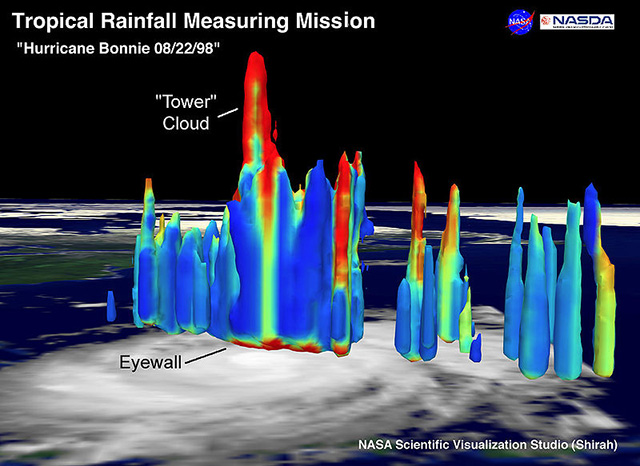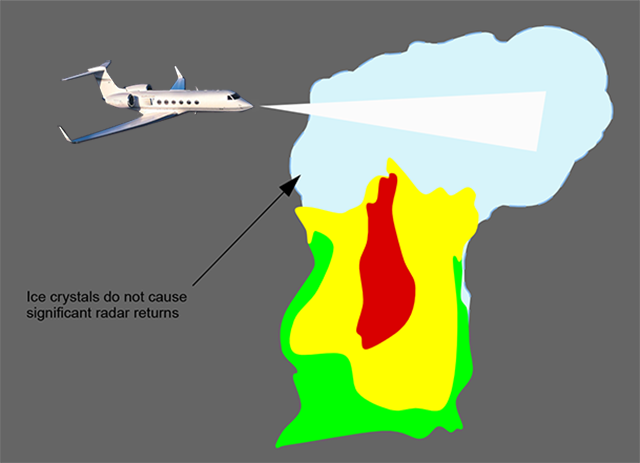There have been quite a few instances where aircraft had been flying along happily at altitude over the ocean when the outside air temperature suddenly rose thirty degrees or so and the aircraft mushed out of the sky. It has been reported by multiple Gulfstreams, usually GIVs, Boeings, and other aircraft. The phenomenon has been called an encounter with "Hot Towers."
— James Albright

Updated:
2017-03-08
I think Boeing probably knows as much about this phenomena as anyone and they provide excellent guidance in their various late model manuals. I've extracted some of these just to give you a flavor of what is involved; you should not follow the procedures for a different aircraft. But if you don't have any procedures, looking at these can give you an idea of the issues. It should, at the very least, dissuade you from thinking what many Gulfstream pilots thought when first encountering the problem.
Gulfstream did a very good study about the problem that noted Hot Towers are real, but they were not related to the temperature rise issue experienced by these aircraft. They circulated a presentation that had all the right facts, but an unfortunate subtitle: "Hot Towers or Not." See: Ice Crystal Icing & Hot Towers. A careful read of the presentation leads you to the right conclusion: the encounters were a result of TAT probe icing, not a Hot Tower. But I continue to meet pilots from Gulfstream that claim Hot Towers caused an actual temperature rise.
Is this a problem? Probably not. But I think a better understanding about what a Hot Tower is and what is causing the problem will help you if you ever encounter the mysterious temperature rise.
2 — Examples of reported encounters
3 — Common trends in reported encounters

1
What is a hot tower?
- They are called hurricanes in the Atlantic, typhoons in the West Pacific, and tropical cyclones worldwide; but wherever these storms roam, the forces that determine their severity now are a little less mysterious. NASA scientists, using data from the Tropical Rainfall Measuring Mission (TRMM) satellite, have found "hot tower" clouds are associated with tropical cyclone intensification.
- [NASA scientists] define a "hot tower" as a rain cloud that reaches at least to the top of the troposphere, the lowest layer of the atmosphere. It extends approximately nine miles (14.5 km) high in the tropics. These towers are called "hot" because they rise to such altitude due to the large amount of latent heat. Water vapor releases this latent heat as it condenses into liquid.
Source: NASA Goddard
- Associated with tropical cyclones and hurricanes
- Occur between 36° North and 36° South latitude
- Diameter up to 3 1/2 miles
- Duration 1/2 to 2 hours
So Hot Towers are real, but you need to be in a tall cumulonimbus cloud, probably a hurricane, to experience one. All of the reported encounters by pilots, however, were in the clear. So what did all these pilots experience?
2
Examples of reported encounters
GIV "Encounter"
- FL 410 over equatorial Africa
- Scattered thunderstorms below
- Cirrus cloud, light turbulence, SAT -63ºC
- A/T disconnect, CAS messages
- SAT at -48ºC continued warming to -26ºC
- EPR indicated low, Mach reduced to .67
- After 22 minutes, temperature rapidly returned to -56ºC
- All systems normal
GIV Second "Encounter"
- Second event, over the Pacific
- Weather conditions and aircraft reaction similar
- Engine vibration developed to exceedance levels
- Engine to idle, reversed course to exit conditions
- Set course for alternate and descended
- Vibration diminished during descent, gone at 15,000’
- Engines inspected - completely normal
GV "Encounter"
- FL 410, Pacific ocean near equator
- Scattered thunderstorms below
- Light turbulence, cirrus cloud, -63ºC
- A/T disconnect,“L-R Eng Backup Air Data”, “MADC Miscompare”
- SAT -48ºC continued warming to -24ºC
- Altimeters and Mach indications all disagreed
- Slow descent after speed decayed
- After 25 minutes temperature rapidly returned to -56ºC
3
Common trends in reported encounters
Source:
- High altitude, ISA or colder temperatures
- Heavy moisture in lower altitudes
- Nearby convective activity
- No radar returns at event location
- In cirrus cloud
- Light to moderate turbulence
- TAT probe anomaly
4
The real cause: ice crystal icing
- Convective activity lofts ice crystals in significant quantities into the upper atmosphere
- Ice crystals, not liquid water
- Invisible to aircraft radar and ice detectors
- No airframe icing
- Crews unaware of potential hazards
- Greatest hazard is loss of engine power
- 150 air carrier events in FAA/Industry data base
- Crystals melt due to compression effects
- Pass through fan section
- Enter core and melt on warm surfaces
- Moisture traps additional crystals
- Ice builds up, sheds into compressor
- Engine surges, rolls back, and flames out
Gulfstream placed their focus on the Total Temperature Sensors
The Boeing Description of Ice Crystal Icing
Many current day Boeing manuals describe ice crystal icing as follows.
- At temperatures below freezing near convective weather, the airplane can encounter visible moisture made up of high concentrations of small ice crystals. Ice crystals can accumulate aft of the engine fan, in the engine core. Ice shedding can cause engine vibration, engine power loss, and engine damage.
- These weather conditions are difficult to detect because ice crystals do not cause significant weather radar returns. They are often found in high concentrations above and near regions of heavy precipitation. Ice crystals do not stick to cold aircraft surfaces.
- Flight in clouds containing ice crystals has been associated with engine vibration, engine power loss, engine damage, and airplane Total Air Temperature (TAT) probe icing.
Source: Boeing 777 FCOM
Recognizing Ice Crystal Icing Weather (Boeing Recommendation)
Ice crystals are most frequently found in areas of visible moisture and above altitudes normally associated with icing conditions. Their presence can be indicated by one or more of the following:
- Appearance of rain on the windshield at temperatures too cold for liquid water to exist. This is due to ice crystals melting on the heated windows (sounds different than rain)
- Airplane TAT indication remains near 0 degrees C due to TAT probe icing
- Areas of light to moderate turbulence
- In IMC with:
- No significant radar returns at airplane altitude and
- Heavy precipitation below the airplane, identified by amber and red radar returns on weather radar
- Cloud tops above typical cruise levels (above the tropopause)
Note: There is no significant airframe icing. The icing conditions detections system does not detect ice crystal icing. It is designed to detect supercooled water only.
Source: Boeing 777 FCOM
Avoid Ice Crystal Icing Weather
- During flight in IMC, avoid flying directly over significant amber or red radar returns, even if there are no returns at airplane altitude.
- Use the weather radar controls to assess weather radar reflectivity below the airplane flight path. Refer to weather radar operating instructions for additional information.
Source: Boeing 777 FCOM
While most radar systems cannot detect or display ice crystals, they can show the wet precipitation below possible areas of ice crystal formation:
- One or more of the following can indicate ice crystal icing:
- Light to moderate turbulence
- Static discharge around the windshield (St. Elmo’s fire)
- Smell of sulfur
- Smell of ozone
- Humidity increase
- An erroneous TAT indication can occur as a result of ice crystals blocking the sensor. The erroneous indication can last from one minute to more than 20 minutes. TAT normally should increase approximately 2 degrees Celsius per 1000 ft of descent.
Source: Boeing 777 FCOM
Ice Crystal Icing Suspected
- Exit the ice crystal icing conditions. Request a route change to minimize the time above red and amber radar returns.
- Do the Ice Crystal Icing non-normal checklist.
Source: Boeing 777 FCOM
Of course you should reference your specific aircraft procedures in lieu of copying another manufacturer's checklist. But what if you don't have any such checklist? Here is a compilation of various Boeing manuals, including the 737, 767, and 777. They give you a good idea of some considerations, but make sure you check your manuals first.
GE Engine Notes: TAT probe icing can cause one or more of the following abnormal engine indications:
- Reference/target N1 indications blank
- Reference/target N1 indications decrease while flying at a constant altitude and airspeed
For GE engines, Boeing recommends you exit the conditions if you can; if your autothrottles are unresponsive, disengage them and set thrust manually to maintain airspeed and altitude.
Rolls-Royce Engine Notes: TAT probe icing can cause one or more of the following non-normal engine indications:
- Reference/target EPR indications or reference EPR blank
- Maximum EPR lines (amber) or reference/target EPR indications decrease while flying at a constant altitude and airspeed
- Thrust levers or actual EPR indications are not aligned
- Unable to achieve maximum continuous thrust or maximum climb thrust
For Rolls-Royce engines, Boeing recommends you exit the conditions if you can; if your TAT indications are near zero and engine indications are not normal, you should revert your engines to the alternate mode. What does this mean? It is different for various engines. In one case it can mean switching EECs in another the control (EPR versus N1) mode. Here again you need to reference your aircraft manual.
5
The Gulfstream total temperature probe (Goodrich)
- Review of sensor specs and fault history
- High MTBR
- 60% heater failures, 2% sensor failures
- Part Number change for PlaneView aircraft
- Performance enhanced in extreme icing conditions
- Inlet scoop change to reduce clogging by ice crystals
- Improved internal heat conduction to critical surfaces
- Increased heater power
- No Hot Tower reports from PlaneView aircraft
- Goodrich engineering confirmed
- Ice crystals can overwhelm heater and clog probe
- Reduced airflow allows heater to warm sensor
- Sensor may read 0ºC, ice point of melting crystals
- 0ºC reported numerous times in airline data base
- Rapid return to normal is consistent with heater clearing ice from probe
- Probes became logical suspects in tower events
- Suspicion only, confirmation needed
- NOAA weather research GIV experienced several unexplained temperature increases at high altitude
- Aircraft records data from numerous sensors
- Production standard total temp probe
- Scientific temperature probes (2)
- Dewpointers
- During some hot tower type events
- Only two of the three temp probes reacted
- Third probe continued to indicate normally
- Dewpointers showed large increase in water vapor
There wasn't enough data to come to a firm conclusion so the Gulfstream study leaves you wondering. The preponderance of evidence, however, leads me to conclude the temperature rise was due to TAT probe icing, not a Hot Tower. There are no corrective actions specified by Gulfstream and I haven't heard of any from other aircraft manufacturers. So what can you do?
- If possible, avoid flight at high altitudes with heavy moisture in lower altitudes and nearby convective activity.
- If encountered, reverse course.
There have been no encounters of this by Planeview aircraft.
References
(Source material)
Boeing 777 Flight Crew Operating Manual, July 18, 1995
NASA Goddard, A "Hot Tower" Above the Eye Can Make Hurricanes Stronger, January 12, 2004
Salamankis, John, Ice Crystal Icing & Hot Towers, Gulfstream Product Support, undated.
Please note: Gulfstream Aerospace Corporation has no affiliation or connection whatsoever with this website, and Gulfstream does not review, endorse, or approve any of the content included on the site. As a result, Gulfstream is not responsible or liable for your use of any materials or information obtained from this site.

